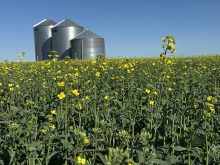Peter Leavitt didn’t rain on farmers’ hopes during his 2007 weather outlook.
The American weather analyst said Canadian prairie farmers should enjoy a nice, unexciting period while farmers elsewhere suffer more dramatic and generally bad conditions.
“It’s going into a La Nada few months,” said Leavitt, in an interview after giving a speech at the Canadian Wheat Board’s Grain World conference.
“We’re transitioning from a weak El Nino into what could be a stronger La Nina.”
La Nada is the humorous term weather analysts have given to the periods between the El Nino and La Nina weather phenomena. The nada means that nothing big is expected to happen.
Read Also

U.S. softens fees on Chinese shipping
The U.S. starts charging new fees on Chinese ships on Oct. 14. What are the ramifications for their ag exports?
“We’re going through the zero, the norm, the neutral zone,” said Leavitt, president of Weather Information Co. in Newton, Massachusetts.
“I don’t look for hot weather. I don’t look for droughty conditions. I think with a generally normal pattern, if you get that crop in the ground, you’re probably going to have a really good opportunity to grow a good crop.”
Recently some weather forecasters have predicted a dramatic La Nina. Weather patterns such as La Nina and El Nino can have big impacts on crops. Last year’s El Nino crippled Australia’s wheat crop, reducing it from a normal 20 million tonnes to about 10 million.
Other forecasters have delivered divergent outlooks. Leavitt said long range forecasts leave open a range of possibilities, but such forecasts are often wrong.
Shorter term forecasts, like the one for the next few months that he is giving, tend to be more likely to be fulfilled, he said.
The beginning of a La Nina, which tends to bring cool weather, won’t necessarily be bad for prairie farmers, Leavitt said. Most prairie soils are already well supplied with moisture and can handle cooler, drier conditions without much stress.
Bruce Burnett, the wheat board’s chief weather analyst, said he has seen little evidence that undermines Leavitt’s argument.
“The forecast is very good,” said Burnett.
“Right now there’s nothing that appears to be terribly threatening on the weather front that’s going to hurt production on the Prairies.”
Problem spots appear in the wet northeast of Saskatchewan and the dry southeast of Manitoba, but generally soils are set to come out of the winter well primed for planting.
Leavitt said long range forecasts can be inaccurate, so he does not put a lot of stock in them.
And while shorter term forecasts tend to be more accurate, weather science is still far from being exact.
“This is the best guess. The shortest odds,” said Leavitt.

















